Review: Lightweight Avalanche Equipment for Ice Climbers
We review the best avalanche rescue equipment for those with light and fast winter objectives
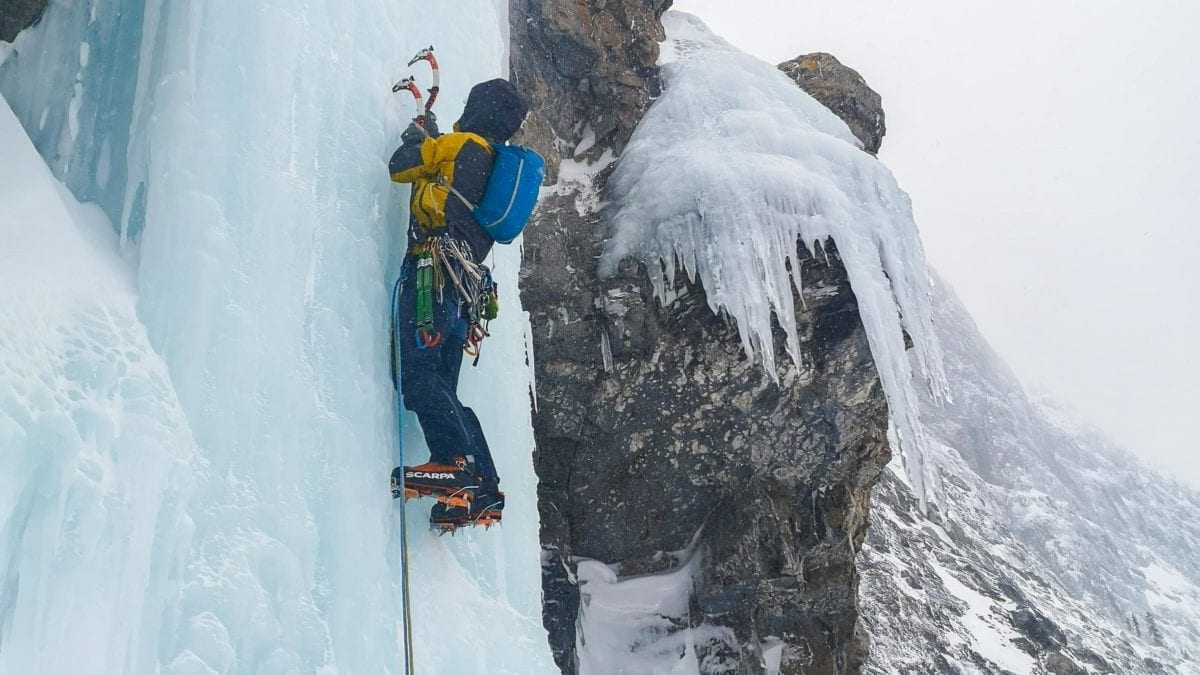 Photo by: Emilie Grenier
Photo by: Emilie Grenier
In February 2019 I skied into the freezing northeast face of Storm Mountain with fuel, food and hardware for two days of loose rock, brittle ice and brutally cold nights. The avalanche hazard bulletin read Moderate-Low-Low for the duration of our trip and we debated stuffing three more pieces of equipment (shovel, beacon and probe) into our already overloaded packs. Aside from a steep 200m snow slope at the very end of our 6km approach, I was confident we could avoid any other avalanche terrain enroute and, lured by the thought of lighter backpacks, we decided to leave our avalanche equipment at home. This fallacious decision could have killed me. With 50m to go on our approach, I set off a slide while wearing a heavy backpack and cumbersome powder skis. Immobile and off balance, a wind slab ripped the snowpack from beneath me and I took a ride. While kicking off my skis I luckily lodged one vertically in the bed surface, arresting my slide while the snow dropped away to the lake below.
In hindsight, my mistakes are obvious and inexcusable. So why, after speaking with several alpine climbers in the subsequent months, did their experiences reflect mine? Our weight-conscious demographic is notorious for leaving the basic necessities behind while climbing in avalanche terrain. It is time we look at the winter hazards exposed to climbers — and standardize what goes into our day packs.
While climbers may travel on avalanche-prone slopes less often than backcountry skiers, James Floyer, the avalanche forecasting program supervisor at Avalanche Canada, says ice climbers and alpinists face a unique set of risks. Unlike skiers, climbers are exposed to the same hazardous terrain all day. Ice often forms at the mouth of large alpine bowls and, while we are shivering away at shaded belays, the slopes above us may be baking in the sun or experiencing intense wind loading. By the constraints of our gully features, ice climbers have nowhere to hide when those bowls slide. Climbers also have a higher degree of vulnerability than skiers. Even a relatively small slide can have high consequences if striking a leader during a tenuous topout or pouring into a narrow slot canyon. Simply walking unroped between pitches can be very dangerous if above high consequence terrain.
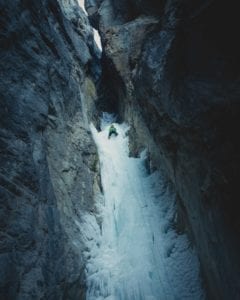
A three-antenna beacon is widely considered to be the bare minimum when climbing in avalanche terrain; read more here to find out why. While there is no distinction between avalanche equipment for ice climbers and backcountry skiers, ice climbers are most likely to prioritize weight and packability. With this criteria in mind, we have reviewed two sets of rescue equipment for the gram-counting, toothbrush sawing alpinist to consider.
Mammut Barryvox
Price: $429.95
Weight: 210g with batteries
Size: 115mm x 67mm
The Barryvox has been a fixture in the avalanche safety world since 1968. It features a 70m search range, shock- and break-proof housing and a backlit display screen allowing for easy reading while wearing polarized sunglasses. From the moment a search is initiated, the Barryvox’s screen guides users through the various stages of rescue; from a wide zig zag to locate the initial signal to a fine comb near the snow’s surface. The Barryvox is able to receive firmware updates from Mammut, allowing users to reuse their beacons for years instead of retiring them once new industry-standard technology becomes available. We appreciated the Barryvox’s straightforward instructions even during a multiple burial scenario and it’s low volume shape. It was certainly not the biggest source of discomfort during a late-November bivy in the Rockies!
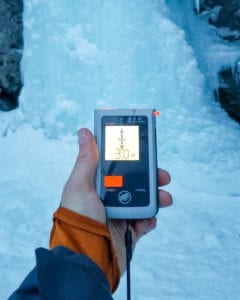
Backcountry Access Tracker S
Price: $319.95
Weight: 165g with batteries
Size: 115mm x 71mm
The Tracker S is an excellent choice for climbers who do not already own a beacon and are looking for an affordable option. It hosts many of the same features as the bestselling BCA Tracker 3, including a maximum range of 55m, with two notable limitations; its firmware cannot be updated and it does not have a motion-sensing revert mode. In other words, if you are searching for your partner and you become buried in a second slide, your beacon will be auto-reverted into send mode after five minutes instead of the Tracker 3’s one minute. The lack of this feature is not a deal breaker for the ice climber who often travels with one other partner, but it is an important absence to note if recreating in larger groups. Aside from this, the Tracker S is a powerful beacon with a simple, user-friendly design that will help accelerate any burial rescue effort.
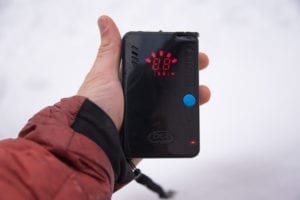
Mammut Probe 240cm Short
Price: $69.99
Weight: 245g
Collapsed length: 38cm
This ultra-compact probe is welcomed news for ice climbers who complain of probes not fitting easily into their leader pack. The 240cm Short collapses into 38cm segments to allow for easy stowing before firing the crux pitch. It is made with durable aluminum to ensure strength and reliability, all while keeping its total weight at a minimum. Upon deployment, its tensioning handle easily clips into the body to prevent it from whipping into your helmet while probing. Although there are certainly benefits to a longer probe length, this probe (paired with the Alugator Light shovel), is intended to encourage all ice climbers to bring avalanche equipment with them. When the gear is this lightweight and compact, there is no longer a legitimate reason not to.
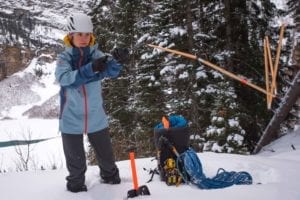
Backcountry Access Stealth 300cm Carbon Probe
Price: $119.99
Weight: 290g
Collapsed length: 43cm
This 300cm option is a strong candidate for one probe to rule them all. As discussed earlier, ice climbs often form in tight gully features where even a small avalanche can fill the space surprisingly quickly. For deep gully climbs or other obvious terrain traps, a 300cm probe is often considered a bare minimum length. The 300 Carbon features large, laser-etched depth markings which are easy to read and won’t wear off with heavy use. This probe has an ingenious locking system to prevent a flapping handle once assembled; it sucks the loose cable up into the probe once deployed to keep your rescue hassle-free.
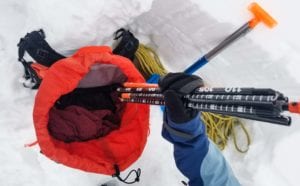
Backcountry Access B-1 EXT Avalanche Shovel
Price: $59.99
Weight: 600g
Blade dimensions: 24.9cm x 25.4cm
The B1-EXT walks the fine line between compact enough to take up a climb, while having a large surface area to efficiently excavate snow for a burial or snow profile. BCA points out that the excavation process is where the most time can be lost or gained in a rescue, and advises on bringing a larger shovel whenever possible. Its extendable aluminum shaft provides ergonomic comfort for prolonged digging with an impressive strength-to-weight ratio thanks to its oval shaped shaft. The blade’s curvature requires thoughtful packing to ensure it carries comfortably in a small bag, but we appreciated how quickly it was able to move large volumes of snow thanks to it’s high-walled edges.

Mammut Alugator Light Shovel
Price: $85.00
Weight: 475g
Blade dimensions: 21cm x 24cm
The Alugator Light makes the decision to bring a shovel into avalanche terrain a no-brainer. Its compact shaft and blade easily stow away into a small day pack with plenty of room for extra food, water and layers. We were impressed with the durability of this shovel given its diminutive size; a sharpened, anodized blade easily cuts through hardened debris while providing a torsionally stiff platform to ensure no wasted energy. Digging with the Alugator Light was more arduous than the B1-EXT due to the smaller surface area, however we were more likely to reach for it when packing for a challenging multi pitch or on low-hazard days.
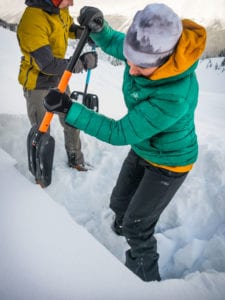
Backcountry Access BC Link Two-Way Radio 2.0
Price: $229.99
Weight: 340g
Like avalanche equipment and backcountry skiers, two-way radios were adopted by our snow sliding compatriots before we climbers began to take notice. Try them out on a day when the wind is howling and your leader is getting dangerously close to a 71m rope stretcher— or any day climbing in the deafening Kicking Horse Canyon — and you will be grateful for the back-up communication. The BC Link’s battery lasts for several cold days before needing a recharge, its weather resistant casing prevents damage while climbing dripping ice or in a bout of spindrift and it is easy to operate while wearing big belay gloves.
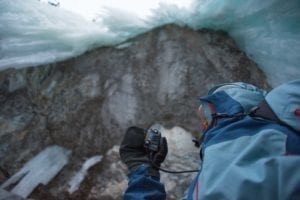
With the advent of durable and lightweight avalanche rescue equipment, ice climbers and alpinists have more options than ever to choose a tool that suits their needs. While larger shovels and extra long probes make a rescue safer and less strenuous, anything you bring will be better than digging out your buddy with an ice tool and helmet.



